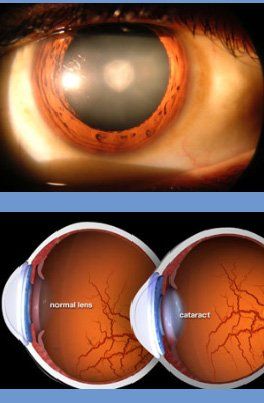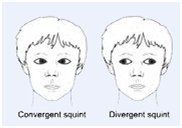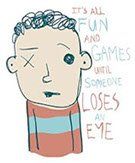Common eye problems in children:
Refractive errors occur when an eye cannot clearly focus the image on the retina, resulting in blurred vision. This in many cases can subsequently lead to a permanent un-correctable disability.
Myopia or nearsightedness is the most common refractive error among children. It occurs when the eye is longer for the focusing system to work properly. In myopia the distance objects appear blurred.
Hyperopia or farsightedness occurs when the eye is shorter, needing the focusing system to overwork to bring the image focused on the retina. Hyperopic children have problems both for near and distance.
Astigmatism
occurs when the power on cornea is not regular. Children with refractive errors can have frequent headache, blurred vision, eye strain and fatigue. These errors can be corrected with glasses. Contact lenses can be tried in early teens.
Strabismus or “Squint”
is caused by the failure of the eye muscles to work together causing the eyes to be misaligned. In a child who has squint, one or both eyes may turn in, out, up or down. The brain corrects resulting double vision by using the better eye to see, and suppressing the squinting eye. This needs to be corrected at the earliest, as delay in treatment can cause permanent visual impairment. Treatment could be glasses, patching, home eye exercises or work ups on VTS4 system. In few children this needs to be followed up by a surgery to straighten the eyes. Surgery is ideally advised around the age of 4 yrs. and it may be on one or both eyes. It is a very safe extra ocular procedure performed under general Anesthesia and at Karthik Netralaya it is always done under Operating Microscope.
The exact cause of squint is not really known. The movement of each eye is controlled by six muscles. Each of these muscle acts synchronisingly with its counterpart in the other eye to keep both the eyes aligned perfectly in all directions. A loss of coordination between the muscles of the two eyes leads to misalignment.
Sometimes hypermetropia (long sight) may lead to inward deviation of the eye. Poor vision in an eye due to diseases like cataract, retinal problems etc. may also cause the eye to deviate. Therefore it is important in every case of squint a thorough eye checkup is done.
The aims of treatment of squint are:
• Preserve or restore vision
• Straighten the eyes & improve cosmesis
• Restore binocular vision
To begin with the eyes are checked for refractive error that may actually be responsible for squint. In many cases (accommodative squint) a correction of refractive error is all that is needed to treat squint!
The Surgery if advised involves loosening or strengthening of muscles so as to restore the balance between two eyes, and achieve good coordination. In some cases, prisms may be needed for exercises or to ease the symptoms.
Amblyopia or “lazy eye”
is a condition where the eye is structurally normal but vision is reduced, due to inadequate visual stimulus in childhood. Uncorrected squint, asymmetrical uncorrected refractive errors, cataract etc. can lead to amblyopia. With early detection, the lazy eye can be corrected.
Eye injuries in children can cause eye damage which can be prevented by:
• Giving only appropriate toys without sharp edges or those which fly & shoot.
• Supervising children while using sharper objects.
• Keeping your child away from hazardous objects, medicines, chemicals, cleaning agents and sprays.
• Giving your child protective eye wear during sports, recreation and lab activities.









